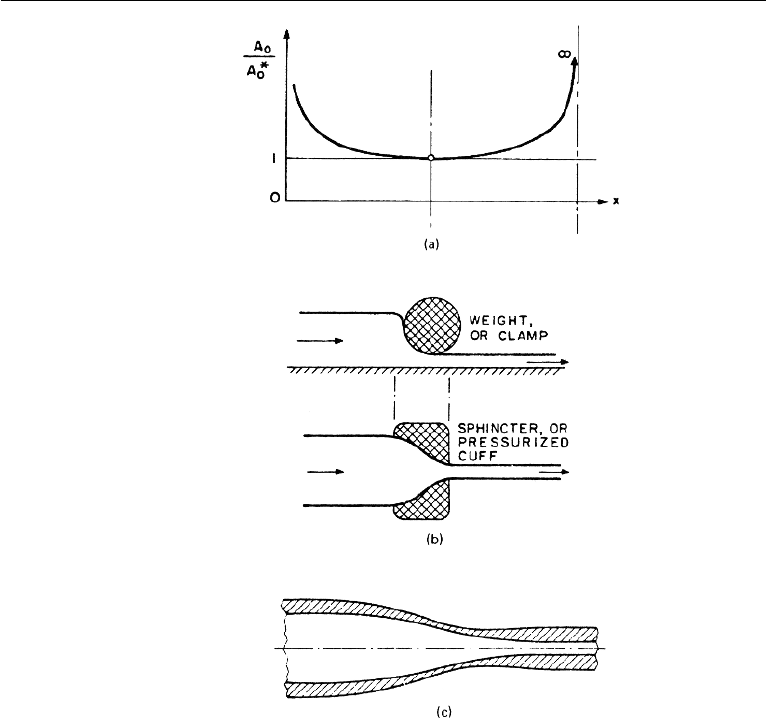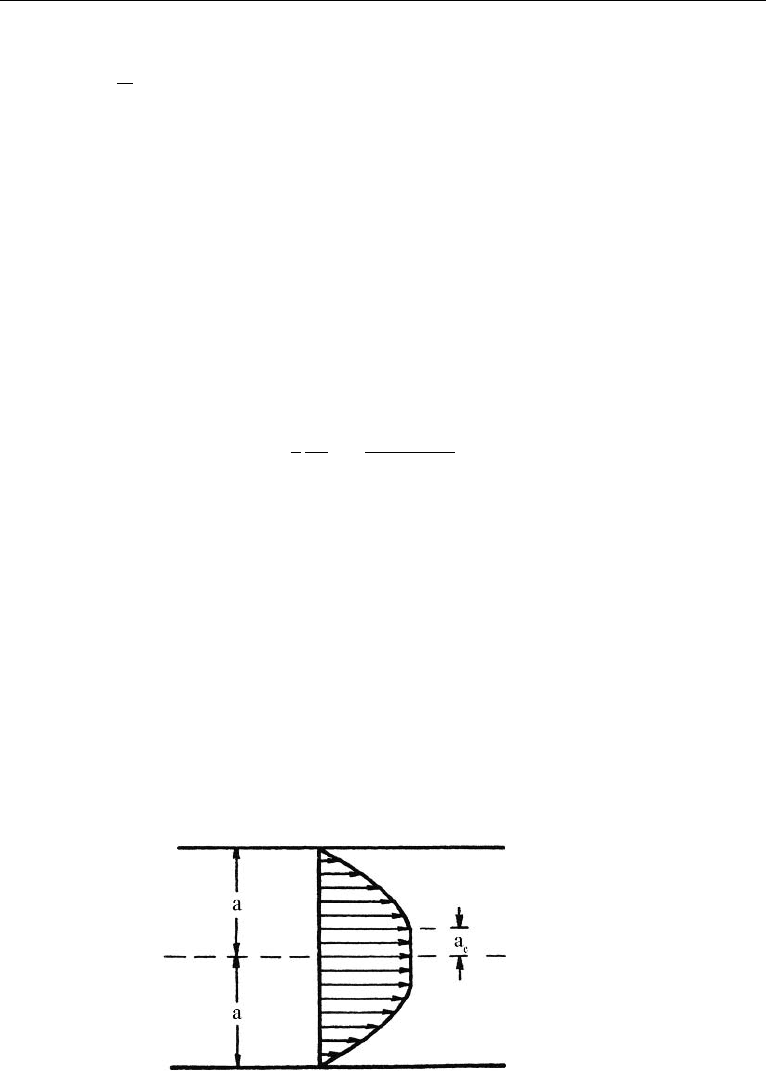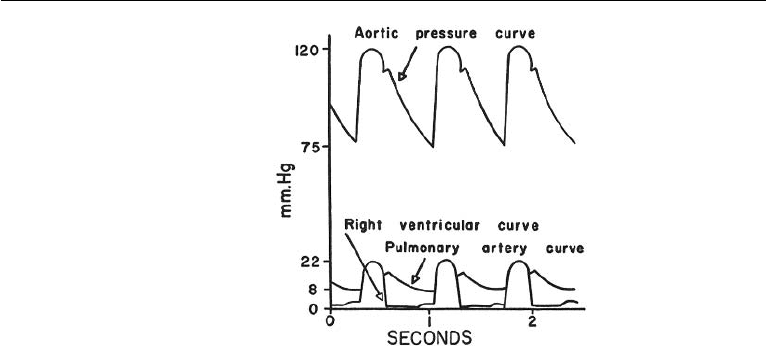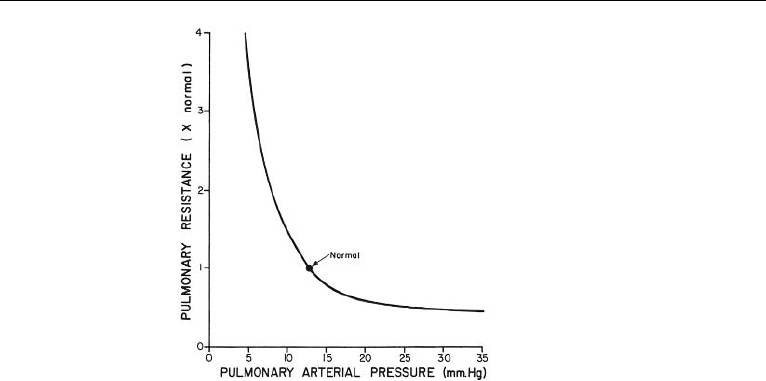Cohen I.M., Kundu P.K. Fluid Mechanics
Подождите немного. Документ загружается.


822 Introduction to Biofluid Mechanics
where K
p
is a parameter proportional to the bending stiffness of the wall material,
and A
0
is the reference area of the tube for zero transmural pressure difference. The
pressure difference is supported primarily by the bending stiffness of the tube wall.
For a linear elastic tube wall material, K
p
is proportional to the modulus of elasticity
E, and the bending moment I ,asin,
K
p
∝ EI, I = (h/a
0
)
3
/(1 −ˆν
2
), (17.187)
where h is wall thickness and ˆν is Poisson’s ratio.
From a fit of experimental data (see, Shapiro (1977a)), the tube law for flow in a
collapsible tube is taken to be,
−P ≈ α
−n
− 1, and n =
3
2
. (17.188)
For P < 0, the tube is partially collapsed. If the tube is in longitudinal tension, say, T
L
,
then there will be a local curvature R
L
in the longitudinal plane. The effect of T
L
is to
change p
e
by T
L
/R
L
, and the tube law equation (17.188) will not hold (see, Cancelli
and Pedley (1985)) . We will here assume that T
L
/R
L
(p − p
e
). Now, if the tube
law equation (17.188) and transmural pressure difference are assumed to be uniform
along the length of the tube, then with equation (17.185), at any location x, the phase
velocity of long area waves is given by
c
2
=
A
ρ
∂(p − p
e
)
∂A
=
nK
p
α
−n
ρ
, (17.189)
for the square of the wave speed.
The assumptions of uniformity of tube law and transmural pressure difference
are not valid under most physiological circumstances and these have to be relaxed.
The physical causes that negate uniformity include: friction, gravity, variations of
external pressure or of muscular tone, longitudinal variations in A
0
, and longitudinal
changes in the mechanical properties of the tube. To address some of these issues, we
consider a more general formulation given by Shapiro.
The flow will still be considered steady, one dimensional, and incompressible.
The governing equations now are:
dA
A
+
du
u
= 0, (17.190)
and,
−Adp − τ
w
sdx − ρgAdz = ρAudu = ρAu
2
du
u
, (17.191)
where, τ
w
is the wall shear stress, s is the perimeter of the tube, z is the elevation in
the gravity field g. For the shear stress, Shapiro (1977a) considers the cases of fully
developed turbulent flow and fully developed laminar Poiseuille flow in the tube. For
turbulent flow,
τ
w
sdx
A
=
1
2
ρu
2
4 f
T
dx
d
e
, (17.192)

3. Modelling of Flow in Blood Vessels 823
where d
e
= 4A/s is the equivalent hydraulic diameter and f
T
is skin friction co-
efficient for turbulent flow, while for laminar flow,
τ
w
sdx
A
=
µu
d
0
1
α
4 f
L
dx
d
0
, where,f
L
(α) =
A
A
e
f
L
, (17.193)
and d
0
is the diameter for A
0
, and f
L
is laminar skin friction coefficient.
With equation (17.190), the equation (17.191) may be written,
d(p + ρgz) +
τ
w
sdx
A
− ρu
2
dA
A
= 0, (17.194)
where the appropriate expression for the shear stress must be introduced depending
on the nature of the flow.
Shapiro (1977a) introduces a dimensionless speed-index, S,
S =
u
c
, so that
dS
2
S
2
= 2
du
u
− 2
dc
c
. (17.195)
This index facilitates in the development of the theory and in the interpretation of
results. Its role is comparable in significance to that of Mach number and Froude
number in gas dynamics and in free-surface channel flow, respectively (Shapiro
(1977a)). By analogy with results of gas dynamics, in steady flow, when S<1
(subcritical), friction causes the area and pressure to decrease in the downstream
direction, and the velocity to increase. When S>1 (supercritical), the area and
pressure increase along the tube, while the velocity decreases. In general, whatever
the effect of changes of A
0
, p
e
, z, etc. in a subcritical flow, the effect is of opposite
sign in supercritical flow. For example, let p
e
be increased while all other independent
variables such as A
0
, elasticity, etc. are held constant. Then A and p will decrease
for S<1, but they will increase for S>1. When S = 1, choking of flow and flow
limitation as at the throat of a Laval nozzle will occur. Again, as in gas dynamics,
there is the possibility of continuous transitions from supercritical to subcritical flow,
and also rapid transitions from supercritical to subcritical as in shock waves.
In the steady flow problem, the known quantities are dA
0
, dp
e
, gdz, fdx, dK
p
,
∂P/∂x, ∂P/∂α, while the unknowns are du, dA, dp, dα, dS and so on.
In order to develop the final set of equations relating the dependent and inde-
pendent variables, a number of useful relationships may be established between the
differential quantities.
The external pressure is p
e
(x), dp
e
= (dp
e
/dx) dx, the area A
0
= A
0
(x), and
dA
0
= (dA
0
/dx) dx. Since α = A/A
0
,
dα
α
=
dA
A
−
dA
0
A
0
. (17.196)
The bending stiffness parameter is K
p
= K
p
(x), dK
p
= (dK
p
/dx) dx, and the tube
law is,

824 Introduction to Biofluid Mechanics
P =
p − p
e
K
p
(x)
= P(α, x), → dp = dp
e
+ K
p
dP + P dK
p
. (17.197)
The appropriate form of equation (17.185) is,
c
2
(A, x) =
A
ρ
∂(p − p
e
)
∂A
x
→ c
2
(α, x) =
α
ρ
K
p
∂P
∂α
x=constant
. (17.198)
In equation (17.197),
dP =
∂P
∂α
dα +
∂P
∂x
dx. (17.199)
With equations (17.198) and (17.199), equation (17.197) becomes,
dp = dp
e
+ ρc
2
dα
α
+ K
p
∂P
∂x
dx + PdK
p
. (17.200)
With equations (17.198) and (17.197), we get,
2
dc
c
=
1 +
α∂
2
P/∂α
2
∂P /∂α
dα
α
+
dK
p
K
p
+
αK
p
ρc
2
∂
∂x
∂P
∂x
dx, (17.201)
and, with equation (17.195), equation (17.196) becomes,
dS
2
S
2
=−2
dα
α
− 2
dA
0
A
0
− 2
dc
c
. (17.202)
We now have equations (17.194), (17.196), (17.200), (17.201), and (17.202).
With these, Shapiro (1977a) has developed a series of equations that relate each
dependent variable as a linear sum of terms each containing an independent vari-
able multiplied by appropriate coefficients (influence coefficients by analogy with
one-dimensional gas dynamics). A comprehensive listing of equations is provided in
the paper by Shapiro. From the listing, the most important dependent variables turn
out to be dα/dx and dS
2
/dx. Once these are known, other dependent quantities such
as P, u, c etc. may be calculated easily. We now list these equations.
Let us consider cases where P is just a function of α alone, that is, P(α). For the
tube law,
p − p
e
(x) = K
p
(x)P(α), (17.203)
the equation governing the variation in α is,
1 − S
2
1
α
dα
dx
=
S
2
A
0
dA
0
dx
−
1
ρc
2
dp
e
dx
+ ρg
dz
dx
+ RQ + P
dK
p
dx
, (17.204)

3. Modelling of Flow in Blood Vessels 825
where R is viscous resistance per unit length (laminar or turbulent) and Q is flow
rate, and the equation governing the speed index is,
1 − S
2
1
S
2
dS
2
dx
=
1
A
0
dA
0
dx
−2 + (2 − M)S
2
+
M
ρc
2
dp
e
dx
+ ρg
dz
dx
+ RQ
+
1
ρc
2
dK
p
dx
MP −
1 − S
2
α
dP
dα
, (17.205)
where
M = 3 +
α∂
2
P/∂α
2
∂P /∂α
. (17.206)
The equations for dα/dx and dS
2
/dx are coupled and must be solved simul-
taneously by using numerical procedures. Shapiro (1977a) has included results for
several limit cases. These include several examples in which a smooth transition
through the critical condition S =1 is possible, that is, continuous passage of flow
from regime S<1 through S = 1 into S>1 might occur. Fig. 17.20 shows the
transition from subcritical to supercritical flow by means of a minimum in the neu-
tral area A
0
. The pressure decreases continuously in the axial direction, and the
area A of the deformed cross section would also decrease continuously in the axial
direction. Fig. 17.20 shows the transition through S = 1 caused by a weight or
clamp, a sphincter or pressurized cuff, due to changing p
e
. The fluid pressure and
the area, both decrease continuously in the axial direction. S = 1 occurs in the
region where a sharp constriction exists.
Pedley (2000) points out that when S =1, the right hand side of equation
(17.205) is −M times that of equation (17.204). Therefore, at S =1, it is possible
for dα/dx or dS
2
/dx to be non-zero as long as the right hand sides are zero. Of the
terms on the right hand side, RQ is associated with friction and is always positive. This
means that at least one of d(p
e
+ρgz)/dx, dK
p
/dx or −dA
0
/dx should be negative,
that is, the external pressure, the height or the stiffness should decrease with x or the
undisturbed cross-sectional area should increase. An example where dz/dx in a ver-
tical collapsible tube is negative (=−1) is the jugular vein of an upright giraffe and
this problem has been discussed in detail by Pedley. Apparently, the giraffe jugular
vein is normally partially collapsed!
In the next section, we shall learn about the modelling of a Casson fluid flow in a
tube. We recall that blood behaves as a non-Newtonian fluid at low shear rates below
about 200/s, and the apparent viscosity increases to relatively large magnitudes at
low rates of shear. The modelling of such a fluid flow is important and will enable us
understand blood flow at various shear rates.

826 Introduction to Biofluid Mechanics
Figure 17.20 Smooth transition through the critical condition. (Reproduced with permission from the
American Society of Mechanical Engineers, NY.).
Laminar Flow of a Casson Fluid in a Rigid Walled Tube
As shear rates decrease below about 200/s, the apparent viscosity of blood rapidly
increases. (See Fig. 17.7). As mentioned earlier, the variation of shear stress in blood
flow with shear rate is accurately expressed by the equation (17.6):
τ
1/2
= τ
1/2
y
+ K
c
˙γ
1/2
, for τ ≥ τ
y
, and ˙γ = 0, for τ<τ
y
, (17.207)
where τ
y
and K
c
are determined from viscometer data. The yield stress τ
y
for normal
blood at 37
◦
C is about 0.04 dynes/cm
2
. In modelling the flow, this behavior must
be included.
Consider the steady laminar axi-symmetric flow of a Casson fluid in a rigid
walled, horizontal, cylindrical tube under the action of an imposed pressure gradient,

3. Modelling of Flow in Blood Vessels 827
(
p
1
− p
2
)
/L. We shall employ cylindrical coordinates (r,θ,x) with velocity com-
ponents (u
r
,u
θ
, and u
x
), respectively. With the assumption of axi-symmetry,
u
θ
= 0, and
∂
∂θ
= 0
. For convenience, we write u
r
component as v, and we omit
the subscript x in u
x
.
The maximum shear stress in the flow, τ
w
, would be at the vessel wall. If the
magnitude of τ
w
is equal to or greater than the yield stress, τ
y
, then there will be
flow. We may estimate the minimum pressure gradient required to cause flow of
a yield stress fluid in a cylindrical tube by a straightforward force balance on a
cylindrical volume of fluid of radius r and length x. For steady flow, the viscous
force opposing motion must be balanced by the force due to the applied pressure
gradient. Thus,
τ
rx
2πrx =−πr
2
(p
|
x+x
− p
|
x
), (17.208)
and, as x → 0,
τ
rx
(r) =
r
2
dp
dx
=
(p
1
− p
2
)r
2L
. (17.209)
The shear stress at the wall, τ
w
=−(a/2)(dp/dx) = (p
1
− p
2
)a/2L. When τ
y
is
equal to or less than τ
w
, there will be fluid motion. The minimum pressure differential
to cause flow is given by (p
1
− p
2
)
|
min
= 2Lτ
y
/a. With τ
y
= 0.04 dynes/cm
2
,
for a blood vessel of L/a = 500, the minimum pressure drop required for flow is
40 dynes/cm
2
or 0.03 mmHg. Recall that during systole, the typical pressures in the
aorta and the pulmonary artery rise to 120 mm Hg and 24 mm Hg, respectively.
For axi-symmetric blood flow in a cylindrical tube, at low shear rates, the fully
developed flow is noted to consist of a central core region where the shear rate is zero
and the velocity profile is flat, surrounded by a region where the flow has a varying
velocity profile (see Fig. 17.21). In the core, the fluid moves as if it were a solid body
(also called, plug flow).
Figure 17.21 Velocity profile for axi-symmetric blood flow in a circular tube.

828 Introduction to Biofluid Mechanics
Let the radius of this core region be a
c
. Then,
τ = τ
y
at r = a
c
, and ˙γ = 0 for 0 ≤ r<a
c
,
a
c
= 2Lτ
y
/(p
1
− p
2
) = a
τ
y
τ
w
,
τ
1/2
= τ
1/2
y
+ K
c
˙γ
1/2
for a
c
<r≤ a. (17.210)
In the core region, ˙γ = 0 ⇒ (du/dr) = 0 ⇒ u = constant = u
c
(say).
Outside the core region, the velocity is a function of r only, and,
˙γ =−
du
dr
=
τ + τ
y
− 2
√
ττ
y
K
2
c
(17.211)
Let (p
1
− p
2
) = p , τ = p r /2L, and τ
y
= p a
c
/2L. From equation (17.211),
−
du
dr
=
1
2K
2
c
p
L
r + a
c
− 2
√
ra
c
(17.212)
By integration,
u =
1
2K
2
c
p
L
4
3
a
c
r
3
−
r
2
2
− a
c
r + C
, (17.213)
where C is the integration constant. With the no-slip boundary condition at the wall
of the vessel, u = 0atr = a,
C =−
4
3
a
c
a
3
−
a
2
2
− a
c
a
. (17.214)
Therefore,
u =
1
4K
2
c
p
L
(a
2
− r
2
) −
8
3
√
a
c
a
3
−
r
3
+ 2a
c
(a − r)
, (17.215)
in (a
c
≤ r ≤ a). With u = u
c
at r = r
c
, in terms of τ
w
and τ
y
, the equation
(17.215) becomes,
u =
aτ
w
2K
2
c
1 −
r
a
2
−
8
3
τ
y
τ
w
1 −
r
a
3/2
+ 2
τ
y
τ
w
1 −
r
a
,
(17.216)
in (a
c
≤ r ≤ a). We get the velocity in the core, u
c
, by setting,
r
a
=
a
c
a
=
τ
y
τ
w
, (17.217)

3. Modelling of Flow in Blood Vessels 829
in equation (17.216). In terms of pressure gradient, a, and a
c
, u
c
becomes,
u
c
=
1
4K
2
c
p
L
√
a −
√
a
c
3
√
a +
1
3
√
a
c
. (17.218)
The volume rate of flow is given by,
Q = πa
2
c
u
c
+
a
a
c
2πrudr. (17.219)
After considerable algebra,
Q =
π
8
1
K
2
c
p
L
a
4
1 −
16
7
a
c
a
1/2
+
4
3
a
c
a
−
1
21
a
c
a
4
. (17.220)
The Casson model predicts results that are in very good agreement with experi-
mental results for blood flow over a large range of shear rates (see, Charm and Kurland
(1974)).
Pulmonary Circulation
Pulmonary circulation is the movement of blood from the heart, to the lungs, and back
to the heart again. The veins bring oxygen depleted blood back to the right atrium.
The contraction of the right ventricle ejects blood into the pulmonary artery. In the
human heart, the main pulmonary artery begins at the base of the right ventricle. It
is short and wide—approximately 5 cm in length and 3 cm in diameter, and extends
about 4 cm before it branches into the right and left pulmonary arteries that feed the
two lungs. The pulmonary arteries are larger in size and more distensible than the
systemic arteries and the resistance in pulmonary circulation is lower. In the lungs,
red blood cells release carbon dioxide and pick up oxygen during respiration. The
oxygenated blood then leaves the lungs through the pulmonary veins, which return
it to the left heart, completing the pulmonary cycle. The pulmonary veins, like the
pulmonary arteries, are also short, but their distensibility characteristics are similar
to those of the systemic circulation (Guyton (1968)). The blood is then distributed to
the body through the systemic circulation before returning again to the pulmonary
circulation. The pulmonary circulation loop is virtually bypassed in fetal circulation.
The fetal lungs are collapsed, and blood passes from the right atrium directly into
the left atrium through the foramen ovale, an open passage between the two atria.
When the lungs expand at birth, the pulmonary pressure drops and blood is drawn
from the right atrium into the right ventricle and through the pulmonary circuit.
The rate of blood flow through the lungs is equal to the cardiac output except
for the 1 to 2% that goes through the bronchial circulation ( Guyton (1968)). Since
almost the entire cardiac output flows through the lungs, the flow rate is very high.
However, the low pulmonic pressures generated by the right ventricle are still suffi-
cient to maintain this flow rate because pulmonary circulation involves a much shorter
flow path than systemic circulation, and the pulmonary arteries are, as noted earlier,
are larger and more distensible.

830 Introduction to Biofluid Mechanics
Figure 17.22 Pressure pulse contours in the right ventricle, and pulmonary artery. (Reproduced with
permission from Guyton, A. C. and Hall, J. E. (2000) Textbook of Medical Physiology, W. B. Saunders
Company, Philadelphia).
The nutrition to lungs themselves are supplied by bronchial arteries which are a
part of systemic circulation. The bronchial circulation empties into pulmonary veins
and returns to the left atrium by passing alveoli.
The Pressure Pulse Purve in the Right Ventricle
The pressure pulse curves of the right ventricle and pulmonary artery are illustrated
in the Fig. (17.22). As described by Guyton (1968), approximately 0.16 second prior
to ventricular systole, the atrium contracts, pumping a small quantity of blood into
the right ventricle, and thereby causing about 4 mmHg initial rise in the right ventric-
ular diastolic pressure even before the ventricle contracts. Following this, the right
ventricle contracts, and the right ventricular pressure rises rapidly until it equals the
pressure in the pulmonary artery. The pulmonary valve opens, and for approximately
0.3 second blood flows from the right ventricle into the pulmonary artery. When the
right ventricle relaxes, the pulmonary valve closes, and the right ventricular pressure
falls to its diastolic level of about zero. The systolic pressure in the right ventricle of
the normal human being averages approximately 22 mmHg, and the diastolic pressure
averages about 0 to 1 mmHg.
Effect of Pulmonary Arterial Pressure on Pulmonary Resistance
At the end of systole, the ventricular pressure falls while the pulmonary arterial
pressure remains elevated, then falls gradually as blood flows through the capillaries
of the lungs. The pulse pressure in the pulmonary arteries averages 14 mmHg which
is almost two thirds as much as the systolic pressure. Fig. (17.23) shows the variation
in pulmonary resistance with pulmonary arterial pressure. At low arterial pressures,
pulmonary resistance is very high and at high pressures the resistance falls to low
values. The rapid fall is due to the high distensibility of the pulmonary vessels.

4. Introduction to the Fluid Mechanics of Plants 831
Figure 17.23 Effect of pulmonary arterial pressure on pulmonary resistance. (Reproduced with permis-
sion from Guyton, A. C. and Hall, J. E. (2000) Textbook of Medical Physiology, W. B. Saunders Company,
Philadelphia).
The ability of lungs to accommodate greatly increased blood flow with little
increase in pulmonary arterial pressure helps to conserve the energy of the heart.
As described by Guyton, the only reason for flow of blood through the lungs is to
pick up oxygen and to release carbon dioxide. The ability of pulmonary vessels to
accommodate greatly increased blood flow without an increase in pulmonary arterial
pressure accomplishes the required gaseous exchange without overworking the right
ventricle.
In the earlier sections, we have discussed several modelling procedures in relation
to systemic blood circulation. The modelling of the blood flow in pulmonary vessels
are similar to what we studied in those sections.
A discussion of gas and material exchange in the capillary beds is beyond the
scope of this introductory chapter and a reference may be made to the article by
Grotberg (1994) for details.
4. Introduction to the Fluid Mechanics of Plants
Plant life comprises 99% of the earth’s biomass (Bidwell (1974), Rand (1983)).
The basic unit of a plant is a plant cell. Plant cells are formed at meristems, and
then develop into cell types which are grouped into tissues. Plants have three tissue
types: 1) Dermal; 2) Ground; and 3) Vascular. Dermal tissue covers the outer surface
and is composed of closely packed epidermal cells that secrete a waxy material that
aids in the prevention of water loss. The ground tissue comprises the bulk of the
primary plant body. Parenchyma, collenchyma, and sclerenchyma cells are common
in the ground tissue. Vascular tissue transports food, water, hormones and minerals
within the plant.
